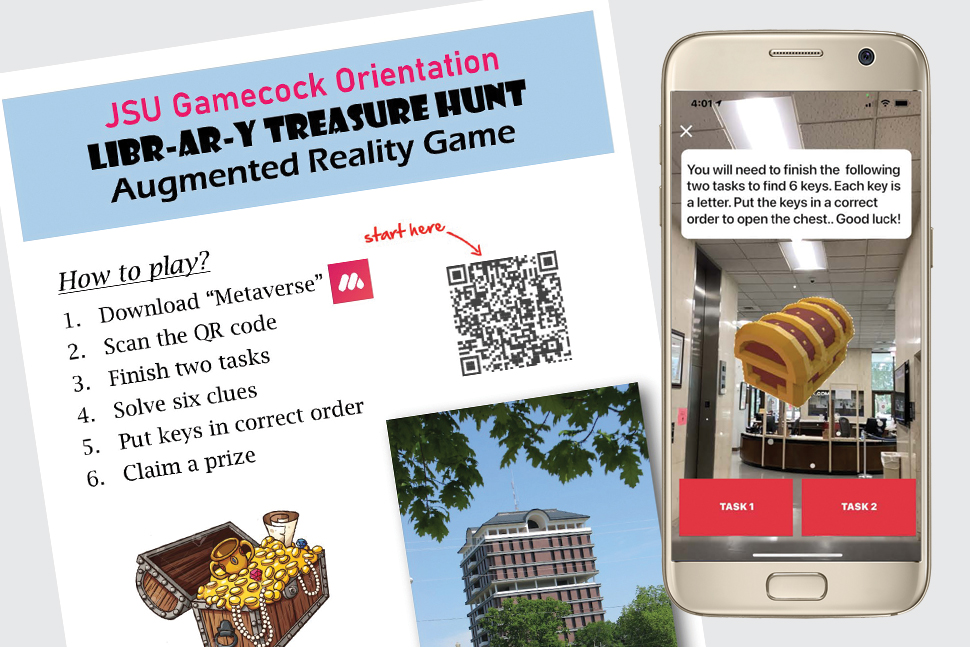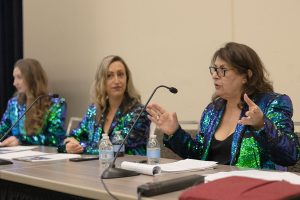
With Gen Z in its higher-education years and Gen Alpha fast approaching, academic libraries are seeking ways to reach tech-savvy students.
“College students, being digital natives, are more inclined to engage with technology-driven learning tools,” says Yingqi Tang, distance education and electronic resources manager at Jacksonville (Ala.) State University’s (JSU) Houston Cole Library.
That’s a major reason many institutions are using augmented reality (AR) to connect with students. Unlike virtual reality, which immerses the user in a computer-generated world, AR integrates digital elements into the physical world in real time through images and sounds. With AR, users can, for example, see a new nail polish color on their actual fingernails, preview a piece of furniture as it would look in their living room, or choose concert tickets by checking out each seat’s perspective in a virtual model of the venue. QR codes often function as a gateway to AR experiences, meaning that just about anyone with a smartphone can easily access them.
Through both student- and library-led initiatives, academic libraries are meeting digital natives on their own turf with AR treasure hunts that double as orientations, opportunities to create room-reservation systems, and other helpful tools.
A digital path
At the Paul Robeson Library (PRL) at Rutgers University–Camden in New Jersey, Samantha Kannegiser, student success librarian, says her main priority is reaching students who aren’t using the library to its full potential. To do this, she looks to emerging technology such as AR.
In 2019, Kannegiser was new to PRL and thought that AR, with which she was already somewhat familiar, would be a good way to get students excited about using the library. She used Zappar, a paid platform that cost $247 for a one-year educator license, to create an AR library orientation. To learn how to do things like find books in the stacks or access online resources, students pointed their phones at QR codes across the library, revealing images and videos “like in Harry Potter,” she says.
Kannegiser spent more than a month learning the program and experimenting before she felt confident bringing her vision to life. “It was definitely a learning curve,” she says. Online tutorials helped her along the way.
But the positive effects of the AR program far outweighed any technical challenges, she adds. Kannegiser says that students who completed the digital orientation displayed a level of interest in the library that isn’t always present in traditional orientations.
Kannegiser did a pre- and post-test with students to gauge how the orientation affected learning outcomes and their comfort in the library. She found it made them “much more confident in navigating the library.” While the program shut down during the pandemic, the library is looking to incorporate AR into programming and orientations in other ways. “I think an exciting next step would be to hold workshops for students to learn how to create AR experiences in the library themselves,” she says.
That same year, at JSU, Tang used a free AR platform called Metaverse to design and implement a library treasure hunt. Students used their phones to scan a QR code, then followed AR puzzles and riddles throughout the library to become familiar with its areas, resources, and subject librarians.
More than 500 students completed the hunt before the Metaverse platform shut down earlier this year. Tang plans to explore other applications for the project. In the meantime, AR “shifted students’ view of the library from a traditional, perhaps intimidating, space to an engaging and welcoming environment,” she says.
Student-led initiatives
At New York University (NYU) Tandon School of Engineering, the Bern Dibner Library of Science and Technology (BDLST) is approaching AR from a different direction: by letting students lead. Through NYU’s Vertically Integrated Projects initiative, students take part in long-term, large-scale multidisciplinary projects—in this case, AR deployments that help other students access library resources.
Matthew Frenkel, NYU engineering librarian, launched the project in 2019. He was inspired by the idea of digitally replicating the “serendipitous discovery” of standing at a bookshelf and finding additional resources related to the one sought. AR, for instance, could make it possible for a user to point their phone at a physical bookshelf and pull up related items that are available only online or that are in storage.
So far, students have used AR to create initiatives such as an iOS app called 3Dibner, which allows library users to view, interact with, and reserve BDLST rooms; an optical-recognition tool that identifies books through images of their covers and spines; and an AR replica of an oversized chess set. “The chess game mimicked a large chess set that we often put out during finals to allow students a study break,” Frenkel explains. “The students decided to try and simulate that through AR so that people could play anytime they want.”
Student turnover from semester to semester means that not all of the students’ AR projects come to fruition. Still, Frenkel notes, the participants gain valuable abilities along the way: “Depending on how the students are involved with the team, they may be learning a large variety of skills ranging from project management and teamwork to user design and user research to a wide variety of front-end and back-end coding skills such as building AR objects, database design, and building user interfaces.”


